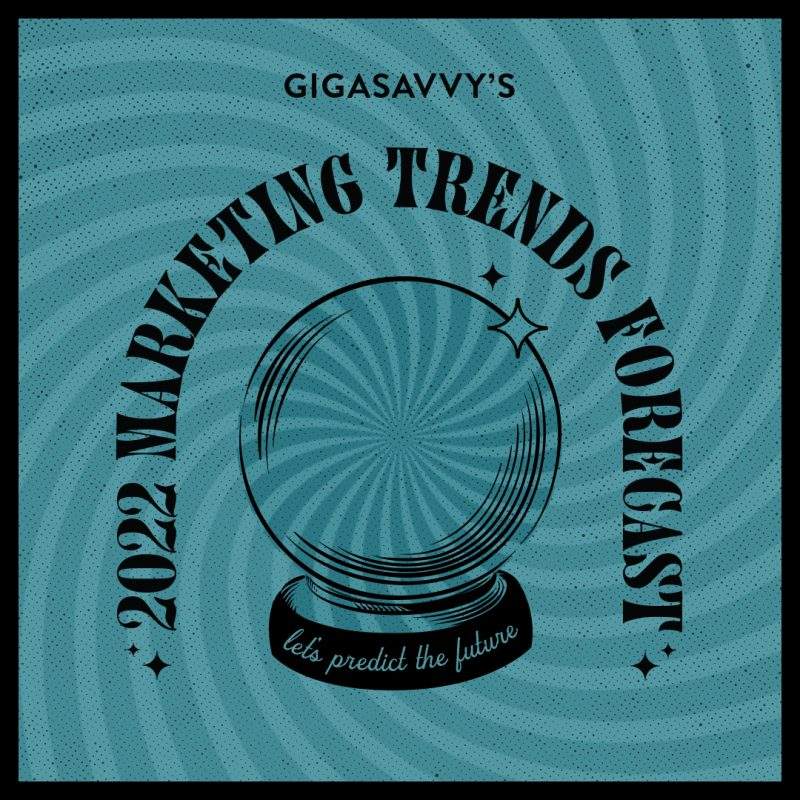Predicting the future is never easy, but when you keep your eye on what’s happening in the marketplace long enough, you develop an intuitive sense for how things might shape up in the months to come. This is our analysis of the leading indicators from 2021 and our predictions for the developments that will make headlines and move markets this year.
Our topline view is that the wild fluctuations in consumer confidence during the pandemic era show no sign of abating, but certain trends are holding steady — and though uneven across industries, the overall economic picture remains strong with positive signs for continued recovery in 2022.
Macroeconomic Factors
According to the U.S. Bureau of Economic Analysis, the last five years have seen volatile swings in both the nation’s GDP growth and the growth of advertising and marketing expenditures in the country. The onset of the pandemic was the triggering event for these changes.
In 2020, as the reality of the pandemic hit domestic and global markets and lockdowns were instituted, GDP and marketing spend both fell precipitously to negative 7.1-percent. The rollout of vaccines and new therapeutics to treat COVID-19 in early and mid-2021 led to a sharp reversal. Lockdowns ended, consumer spending and confidence picked back up and the national economy began a healthy recovery.
The emergence of virus variants, Delta (first detected in late 2020) and Omicron (first detected in late 2021) tempered that recovery. Third quarter estimates for the U.S. GDP growth has been pegged at 2.3-percent — less than some hopeful forecasts, but still well above the nadir at the most uncertain period of the pandemic.
Marketing spend likewise, has tracked closely to GDP, as brands and entire sectors of the economy (notably hospitality industries) came back online, then wavered under the threat of the variants. Other industry sectors — including predictably, healthcare-related businesses and consumer packaged goods (CPG) — saw continuous demand and held steady or increased their marketing and advertising throughout the pandemic era.
Marketing and Advertising Investment Trends
Not Even a Pandemic Can Stop Digital’s Rise
One trend that predated the pandemic and which continues unabated is the shift away from offline marketing expenditure towards digital channels: Winterberry Group management consultants reported that $133.9 billion was spent in 2018 on digital marketing, compared to $233.6 billion devoted to offline channels, a split of roughly two-thirds offline to one-third online.
Winterberry estimates that in 2022, $262.4 billion was spent on digital marketing and $196.7 billion on traditional offline marketing and advertising, a reversal where the majority (57.2-percent) of U.S. marketing was digital. The total compound annual growth rate (CAGR) between 2018 and 2022 in domestic marketing was estimated to be a 5.7-percent increase by Sage.
The Omnichannel Makes Room for Newcomers
Though the more recent quarters of the pandemic have seen a rebound in growth, it was not felt evenly across industries or channels. In offline channels, linear TV, newspapers, and magazines all saw declines in ad spend, whereas addressable TV, traditional outdoor, and sponsorships saw sizable increases, as did shopper marketing, according to Winterberry’s research.
By contrast, growth in digital was positive across channels, with some outperforming others. Paid social, search, and display ads remained by far the three largest areas brands devoted their marketing and advertising budgets to, but the biggest areas of growth year-over-year were influencer marketing, digital out-of-home, and digital video (OTT) and streaming.
The conclusion to be drawn from Winterberry’s research is that Google and Facebook, the respective leaders in search and social, aren’t going anywhere soon, but upstart channels — like rapidly proliferating video streaming services as well as apps that encourage influencer marketing such as TikTok — are growing fast and may soon rival the older tech giants.
Regarding streaming services, a survey by Piplsay published in July of 2021 found that ad-supported video streaming is an increasingly popular option. The most-watched free video streamer was NBCUniversal’s Peacock, followed by The Roku Channel, ViacomCBS’s Pluto TV, Fox’s Tubi, and Amazon’s IMDbTV. Disney’s Hulu was the most preferred paid service with ads.
Data Spend
Another fast-growing sector for brand investment has been data and data services. In 2021, an estimated $27.1 billion was spent on analyzing the data of U.S. consumers to optimize the customer experience and brand outreach. Digital media data analytics made up the lion’s share of the spend and saw the largest growth at 25.1-percent.
TV data analytics made up a smaller portion of the total spend at roughly 15-percent but saw almost equally fast growth at 21.6-percent. The rise of programmatic TV ad buying and pure-play digital video streaming services has untapped a wealth of new data for marketers and brand managers to incorporate into their marketing automation planning, data optimization strategies, and customer relationship management (CRM) platforms.
2022 Marketing and Advertising Outlook
Here are seven key areas we have analyzed for changes to watch as this year develops:
1. The Digital Revolution Won’t Be Stopped
Consumers have gotten a taste for customized experiences, and now personalization isn’t just preferred, it’s expected. Meeting and exceeding customer expectations is of paramount importance when establishing brand trust and delivering a brand experience that promotes loyalty and advocacy.
Delivering personalized experiences at scale isn’t possible without robust digital tools and advanced marketing automation. Consequently, the growth in digital spend seen in 2021 has almost certainly not peaked.
2. The Appetite for Content Won’t Be Satisfied
Even with a firehose of new videos, articles, podcasts, photos, and interactive experiences to drink from, there still never seems to be enough to satisfy the desire for fresh, relevant, and engaging content.
Audiences are always hungry for more, fickle about where they want to invest their eyes and ears in the attention economy, and quick to abandon an outlet that loses its luster or fails to keep pace with an always-on and on-demand world of information, entertainment, and commerce.
For adaptive brand managers, the challenge will be to keep up with demand while staying in tune with the content and channels that appeal to their target demographics, and maintaining quality — but without letting costs go uncontrolled. Content marketing, like all marketing, still needs data-vetted KPIs to justify it.
3. Direct-to-Consumer Will Expand Into New Markets
Mail-order razor blades and meal kits were just the beginning. In 2022, everything from cars to home goods to health services will be marketed, sold, and distributed online and delivered directly to consumers (DTC).
In fact, the entire concept of DTC will evolve into a more holistic framework where a unified brand experience will be delivered over a variety of physical and digital distribution networks. BOPIS (Buy Online, Pickup in Store) and BORIS (Buy Online, Return In Store) will continue to grow in availability — even after the pandemic subsides.
Amazon’s investment in several new, digitally-enhanced brick and mortar retail stores, including its “Just Walk Out” grocery stores and more recently, a clothing store with digital fitting rooms, are clear signs they expect foot traffic to pick back up in 2022 and beyond.
Consequently, retail will reallocate its marketing spend to better address the upper and mid-funnel in an effort to gain stronger awareness and deeper consideration from consumers faced with more options. The brands that best execute a multi-faceted retail strategy (and most clearly communicate their capabilities) will see outsized attention and revenue growth.
4. Privacy Will Be a Key Brand Differentiator
And consumers will quickly realize who is merely paying lip service and who is actually putting skin in the game to protect privacy rights. The EU’s General Data Protection Regulation (GDPR) is just the first of a wave of new laws that will penalize organizations that are careless with sensitive data. Nations worldwide are recognizing the danger of letting personally identifiable information (PII) and customer data go unregulated.
Consumers will increasingly opt for brands that promote greater privacy protections. The fact that DuckDuckGo, the privacy-focused search engine which grew by 46-percent in 2021, is the first competitor in recent memory to gain any serious traction against Google’s dominant position is proof positive that this trend is just heating up.
Apple’s decision to make third-party tracking opt-in rather than opt-out will also continue to shift the balance of power in the privacy space. Brands will steadily lose access to cheap and readily available third-party user data, making fine targeting and attribution that much more challenging. As a result, smart brands will invest in collecting and leveraging more of their own first-party data, while continuing to invest in higher quality creative and branded content.
5. Linear and Advanced TV Will Converge
Where and how consumers access TV content will become less and less relevant to them. They will use smart TVs, phones, tablets, even wearables, and access their media over the air, on the web, and via a wide variety of devices.
The content itself will overshadow the format. 2022 may be the first year in history to challenge legendary media theorist Marshall McLuhan’s famous adage: “The medium is the message.” After all, when every format is converted into a “smart” device that has similar capabilities, it’s all one, ubiquitous medium. We’re not there yet, but the early indicators are emerging now.
6. B2B Will Look More and More Like B2C
The Amazon Effect won’t spare a company just because they are strictly selling to other businesses. Absolutely everyone now knows it’s possible to deliver fast, convenient, high-quality products and services 24/7/365 — and they want it from everyone they patronize.
The internet means switching costs are low, options are plentiful, and anyone that can’t or won’t meet this new demand will see their customer base rapidly defect to competitors that will. Hence, even the most staid and technical of firms will reinvest in their online presence, customer service options, and their brand experience.
7. Experiential Marketing Will Remain in a Holding Pattern
CES 2022 attempted to find out if it was time to bring in-person marketing expos back in full force with decidedly mixed results. Audiences are still skittish about venturing too far into public while the pandemic remains uncontrolled.
However, the heydays of pre-pandemic Instagram Museums and lively in-person experiential marketing events will no doubt eventually return — even amid all the hype surrounding Zoom conferences, virtual reality, and the metaverse — because there is still no substitute for the visceral and emotional connection of truly being with another person face to face in real-time.
The Takeaway
With the pandemic’s end still not entirely in sight, volatility is still the order of the day for most brands, but there are strong signs of progress and insight-driven, human-centered marketing’s effectiveness continues to grow year after year. We expect 2022 to show a continued focus on authentic, brand-based creative strategies to meet consumer demands.


